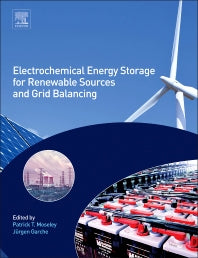Freshly Printed - allow 10 days lead
Couldn't load pickup availability
Electrochemical Energy Storage for Renewable Sources and Grid Balancing
Describes the scientific and engineering development of electrochemical storage systems (batteries, supercapacitors, and hydrogen/fuel cells) for storing renewable electricity and for grid-balancing to optimize the use of the grid
Patrick T. Moseley (Edited by), Jürgen Garche (Edited by)
9780444626165, Elsevier Science
Hardback, published 23 October 2014
492 pages, 140 illustrations
27.8 x 21.5 x 3 cm, 1.37 kg
Electricity from renewable sources of energy is plagued by fluctuations (due to variations in wind strength or the intensity of insolation) resulting in a lack of stability if the energy supplied from such sources is used in ‘real time’. An important solution to this problem is to store the energy electrochemically (in a secondary battery or in hydrogen and its derivatives) and to make use of it in a controlled fashion at some time after it has been initially gathered and stored. Electrochemical battery storage systems are the major technologies for decentralized storage systems and hydrogen is the only solution for long-term storage systems to provide energy during extended periods of low wind speeds or solar insolation. Future electricity grid design has to include storage systems as a major component for grid stability and for security of supply. The technology of systems designed to achieve this regulation of the supply of renewable energy, and a survey of the markets that they will serve, is the subject of this book. It includes economic aspects to guide the development of technology in the right direction.
Introduction – Renewable energies, markets and storage technology classification 1. Renewable Energies for power generation – Technologies, potentials, needs for balancing power 2. Classification of technologies for balancing power in grids 3. Challenges for the power supply systems – grid restrictions, demand side management, conventional power plant operation 4. Existing markets and operation profiles for grid connected storage systems – Primary control, secondary control, minute reserve, energy trading, power plant scheduling, UPS systems, self-consumption 5. Existing markets for storage systems in off-grid applications 6. Review on the need of storage capacities depending on the share of renewable energies Storage Technologies 7. Overview about non-electrochemical storage technologies 8. Hydrogen production from renewable energies – electrolyser technologies 9. Hydrogen storage technologies 10. Hydrogen conversion into electricity and thermal use 11. Reversible fuel cell 12. Energy carriers made from hydrogen 13. Lead–Acid Battery Energy Storage 14. Nickel–cadmium Battery Energy Storage 15. Sodium High Temperature Batteries Energy Storage 16. Lithium-ion Battery Energy Storage 17. Redox Flow Battery Energy Storage 18. Metal storage / Metal air (Zn, Al, Mg, Li) 19. Electrochemical Double Layer Capacitors System Aspects 20. Battery management and battery diagnostics 21. Life cycle cost calculation and comparison for different reference cases and market segments 22. ‘Double use’ storage systems – ‘PV Self-Consumption’ and ‘Vehicle to Grid’
Subject Areas: Alternative & renewable energy sources & technology [THX], Energy conversion & storage [THRH], Materials science [TGM], Chemical engineering [TDCB]


